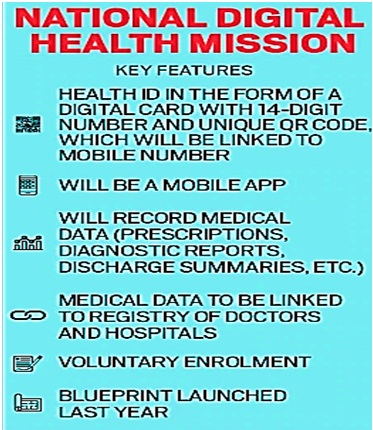National Digital Health Mission
- 17 Aug 2020
- On 15th August, 2020, the Prime Minister launched the National Digital Health Mission(NDHM) while addressing the nation from Red Fort on India's 74th Independence Day.
Background
- The National Health Policy 2017 had envisaged creation of a digital health technology eco-system aiming at developing an integrated health information system that serves the needs of all stakeholders and improves efficiency, transparency and citizens’ experience with linkage across public and private healthcare.
- In the context of this, central government’s think-tank NitiAayog, in June 2018, floated a consultation of a digital backbone for India’s health system — National Health Stack.
- As part of its consultation, NitiAayog proposed a Digital Health ID to “greatly reduce the risk of preventable medical errors and significantly increase quality of care”.
- This proposal was then further taken up by the Central government with the Ministry of Health and Family Welfare, the NHA, and the Ministry of Electronics and IT preparing a strategy overview document for “Making India a Digital Health Nation Enabling Digital Healthcare for all”.
Salient Features NDHM
Implementation
- National Health Authority (NHA), the attached office of the Ministry of Health & Family Welfare and the apex Central Government agency responsible for the implementation of Ayushman Bharat Pradhan Mantri Jan ArogyaYojana, has been given the mandate by the Government of India to design, build, roll-out and implement the NDHM in the country.
Pilot Project
- In its first phase, the mission will begin in Union Territories such as Andaman & Nicobar Islands, Chandigarh, Dadra & Nagar Haveli, Daman & Diu, Lakshadweep, Ladakh and Puducherry.
Creation of National Health Id System
- Under the mission, every Indian will get a new Aadhar-like health ID that will store the individual's medical records, including doctor visits, diseases, the line of treatment and drugs taken.
- This will also come integrated with the facility of using telemedicine, e-pharmacy, creating a national health registry.
- One copy of a patient’s records are stored in their doctor’s files and one is stored in their own individual locker (which can be owned by a company or by the government).
- Other than the registry of doctors, professionals, and institutions, this allows for decentralised storing.
- From a doctor’s appointment to hospitalisation for any treatment, this ID will become essential.
Key Building Blocks
- The NDHM comprises six key building blocks or digital systems namely, Health ID, Digi Doctor, Health Facility Registry, Personal Health Records, e-Pharmacy & Telemedicine – that will enable access to timely, safe and affordable healthcare through a ‘citizen-centric’ approach.
- The vision is to create a national digital health ecosystem which provides timely and efficient access to inclusive, affordable, and safe healthcare to all citizens.
Leveraging Technology
- The key feature of this mission is the technology part - it will leverage open digital systems to provide high-quality healthcare for all.
- It will integrate various digital health services to create an ecosystem which can assimilate existing health information systems.

Significance
- Achieving Universal Health Coverage:NDHM will significantly improve the efficiency, effectiveness, and transparency of health service delivery and will be a major stride towards achievement of the United Nations Sustainable Development Goal 3.8 of Universal Health Coverage, including financial risk protection.
- Reducing Existing Gaps:The NDHM is a holistic, voluntary healthcare programme that will reduce the existing gap between various stakeholders such as doctors, hospitals and other healthcare providers, pharmacies, insurance companies, and citizens by bringing them together and connecting them in an integrated digital health infrastructure.
- Empowering Citizens:It will help to liberate citizens from the challenges of finding the right doctors, seeking appointment with them, payment of consultation fee, making several rounds of hospitals for prescription sheets, among several others and will empower all Indians with the correct information and sources enabling them to take an informed decision to avail the best possible healthcare.
Challenges
- However, with India still lacking a law on data protection, the digital health mission and the semblance of the policy to Aadhaar is expected to trigger privacy concerns in the days to come.
|
Global Instances of Centralised Health Record System
|


